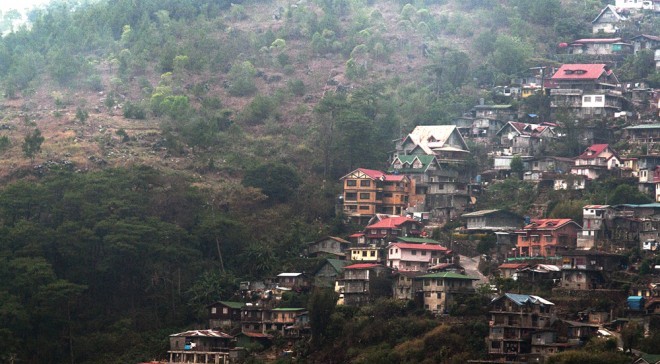
URBAN BLIGHT Houses and other structures rise on every available space at Quirino Hill in Baguio City. INQUIRER FILE PHOTO/RICHARD BALONGLONG
BAGUIO CITY—The big chill has returned to the summer capital, with Tuesday morning’s temperature down to 11.8 degrees Celsius.
Benedicto Alhambra, Baguio City tourism officer, said this is a welcome start of chilly mornings which residents and visitors pine for each time the year ends.
Alhambra said Baguio’s climate was the best reason for tourists to frequent the mountain city.
The coldest temperature in Baguio was recorded on Jan. 18, 1961 when the temperature plunged to 6.3 degrees Celsius.
This month, the mercury dropped to 12 degrees Celsius on Dec. 17 and 18, but temperatures rose slightly to 16 degrees and 15.6 degrees on Christmas eve and Christmas day, respectively.
The city started to cool down further when temperatures dropped to 15 degrees on Dec. 26; 14 degrees on Dec. 27; 13.6 degrees on Dec. 28; and 13 degrees on Monday.
Wilson Lucando, Baguio weather observer, said this weather pattern will continue until February due to the cold front.
But while the local tourism industry draws its best revenues yet since Dec. 1 because of the nippy weather, the city government is anticipating a potential backlash from Christmas holiday visitors whose travel was spoiled last week by traffic jams stretching from the outskirts of Metro Manila to La Union province.
“Gasoline prices were down so more people used their cars to travel to Baguio,” Alhambra said.
He said contractors also opened a portion of the Tarlac-Pangasinan-La Union Expressway (TPLEx) which was designed to reduce travel time to Baguio to at least four hours when it is completed.
As a result, Alhambra said, the city government was unprepared for the volume of visitors who motored to Baguio from Dec. 24 to 26, many of whom were already frustrated by the crawling traffic on TPLEx, the Subic-Clark-Tarlac Expressway (SCTEx) and the North Luzon Expressway (NLEx) during that period.
Baguio has received some bad reviews online and on social media, he said, because weary tourists had to confront the same traffic problems here, on top of difficulties finding places to stay because all hotels and inns were booked since the start of December.
In January, after the New Year holiday break, the city government will gather various agencies and the private sector to hammer out solutions before the city’s next crowd-drawing event, the annual Baguio Flower Festival, in February and the Holy Week break, Alhambra said.
Given the city’s narrow roads and the absence of wide parking spaces, Baguio hotels need to provide shuttle services for their visitors to encourage them to leave their vehicles at the establishments, he said.
“We also need to resolve the problem of parking. We have new hotels being built but we need to enforce regulations which require them to allot appropriate parking spaces according to the number of their projected occupants,” he said. “We need to unclog side streets so these could be part of the traffic flow instead of their current role as staging area for public utility vehicles.”
Alhambra said the city’s tourist arrivals this month were double the record set in the same period last year. This meant an estimated increase to 215,462 visitors from 107,731 visitors in December 2013.
The 2013 Baguio Tourism Arrivals report given by the city tourism office showed that 843,473 tourists visited the city last year. With a report from Jhoanna Marie Buenaobra, Inquirer Northern Luzon